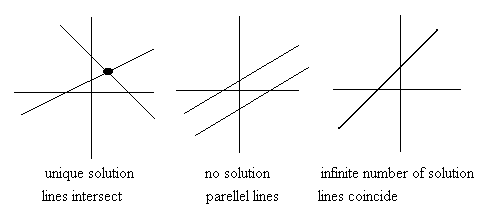Solution types
Geometrically, it is clear that there are three possibilities for the solution of two
linear equations in two unknowns

The same possibilities hold for systems of three or more equations.
Example: Solve
æ x + 2y - 3z = -2 ö
ç 3x - y - 2z = 1 ÷
è 2x + 3y - 5z = 3 ø
|
é 1 2 -3 | -2 ù
ê 3 -1 -2 | 1 ú
ë 2 3 -5 | 3 û
|
R2 > R2 - 3 R1
R3 > R3 - 2 R1
|
Eliminate the entries below the the first diagonal entry.
The required multipliers are 3/1 = 3 and 2/1 = 2.
The calculations leading to a new row 2 are
3-3(1) = 0, -1-3(2) = -7, -2-3(-3) = 7, 1-3(-2) = 7.
The calculations leading to a new row 3 are
2-2(1) = 0, 3-2(2) = -1, -5-2(-3) = 1, 3-2(-2) = 7.
é 1 2 -3 |-2 ù
ê 0 -7 7 | 7 ú
ë 0 -1 1 | 7 û
|
R2 > R2/-7
|
Simplify the second row by dividing by -7.
é 1 2 -3 |-2 ù
ê 0 1 -1 |-1 ú
ë 0 -1 1 | 7 û
|
R3 > R3 + R2
|
Eliminate the entry below the second diagonal entry.
The multiplier is -1/1 = -1 and the calculationsleading to a new row 3 are
0+0 = 0, -1+1 = 0, 1+(-1) = 0, 7+(-1) = 6
é 1 2 -3 |-2 ù æ x + 2y - 3z = -2 ö
ê 0 1 -1 |-1 ú OR ç y - z = -1 ÷
ë 0 0 0 | 6 û è 0z = 6 ø
|
Solve the new system using back substitution.
Since the third equation 0z = 6 is impossible
the original system has no solution.
Example: Solve
æ x + 2y - 3z = -2 ö
ç 3x - y - 2z = 1 ÷
è 2x + 3y - 5z = -3 ø
|
é 1 2 -3 | -2 ù
ê 3 -1 -2 | 1 ú
ë 2 3 -5 | -3 û
|
R2 > R2 - 3 R1
R3 > R3 - 2 R1
|
Eliminate the entries below the the first diagonal entry.
The required multipliers are 3/1 = 3 and 2/1 = 2.
The calculations leading to a new row 2 are
3-3(1) = 0, -1-3(2) = -7, -2-3(-3) = 7, 1-3(-2) = 7.
The calculations leading to a new row 3 are
2-2(1) = 0, 3-2(2) = -1, -5-2(-3) = 1, -3-2(-2) = 1.
é 1 2 -3 |-2 ù
ê 0 -7 7 | 7 ú
ë 0 -1 1 | 1 û
|
R2 > R2/-7
|
Simplify the second row by dividing by -7.
é 1 2 -3 |-2 ù
ê 0 1 -1 |-1 ú
ë 0 -1 1 | 1 û
|
R3 > R3 + R2
|
Eliminate the entry below the second diagonal entry.
The multiplier is -1/1 = -1 and the calculations
leading to a new row 3 are
0+1(0) = 0, -1 +1(1) = 0, 1+1(-1) = 0, 1+1(-1) = 0.
é 1 2 -3 |-2 ù æ x + 2y - 3z = -2 ö
ê 0 1 -1 | 1 ú OR ç y - z = -1 ÷
ë 0 0 0 | 0 û è 0z = 0 ø
|
Solve the new system using back substitution.
Notice that in the third equation 0z = 0 it is possible z to be any number.
We then solve for x and y in terms of z.
y - z = -1, y = z - 1
x + 2y - 3z = -2, x + 2(z-1) - 3z = -2, x - z = 0, x = z
Hence, we have an infinite number of solutions of the form
æ x = z ö
ç y = z -1 ÷
è z = any number ø
|
Exercises
| Table of Contents |
| Previous |
| Next |

